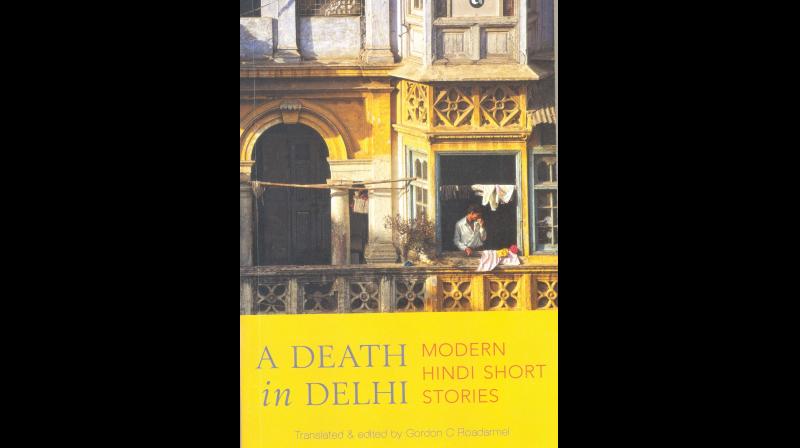How the ‘Khan Market’ lingo has been part of a modernising India

CHENNAI: Not everything about the ‘Khan Market’- a metaphor that resonated loud and clear during the recent Lok Sabha elections- may be bad after all. Leave alone highbrow intellectual stuff, even ordinary chronicles of the 1960s’ make references to this place in Delhi, so much part of the story of modern India.
To get a whiff of it, one just needs to sample this dialogue from the famous Hindi writer Kamleshwar (1932-2007) from his short story titled ‘ A Death in Delhi’, so subtly and wonderfully weaved around a multi-cultural neighbourhood people’s reaction to joining the funeral procession of a famous man, after people read about in the Newspaper that “Seth Diwanchand, the renowned and beloved Karlolbagh business magnate” has passed away at the Irwin hospital.
The news report also mentions that the funeral of the venerable businessman has been scheduled for the next day morning and “it will proceed by way of Arya Samaj Road to Panchkuin cremation grounds for the last rites.” And then Kamleshwar, acknowledged as one of post-Independent India’s most prominent Hindi writers and who had also worked as a scriptwriter for Hindi movies and TV serials, sets the ball rolling on how different people in the neighbourhood wish to join the funeral, or reluctantly join after their initial hesitations.
Characters in that short story even discuss what dress they should wear for the funeral - strange? Not so strange if you look at the pragmatics of the situation as some have to get to office straight after attending the last rites of Diwanchand! There is a conversation between Atul Mawani and his Sardarji friend in the locality, which goes like this:
“Two minutes later, the Sardarji starts down the stairs. Meanwhile, Vaswani spots Mavani from upstairs and asks ‘Where did you get that suit tailored?’”
“Over in Khan Market.”
“It’s very nicely done. I’ll like to get the tailor’s address from you.” Then he calls his wife, “Come on dear! I’ll be waiting for you downstairs.” Joining Mawani and the Sardarji, he feels the suit material. “The lining is Indian?”
“English!”
“It fits beautifully,” he says, jotting down the tailor’s address………”
Kamleshwar, also a Sahitya Akademi award winner, first published this Hindi short story first in 1963.
What is very significant about these lines from that short story is how the author has subtly brought out the changing values in a society on a modernist course, though nothing much has really changed in a society where traditional mores still underwrite and grid the changes that a modern outlook and technology brings.
This collection of 15 modern Hindi short stories, translated and included by the late Gordon C Roadarmel, who taught Hindi language and literature at the University of California, Berkeley, was first published in the year 1972 by the University of California Press. They have now been re-published for the first time in India this year. What stands out is their sociological fragrance even 47 years later, even for poor readers of literature who would have hardly read them in their original or even for linguistic outsiders! As a modern existentialist philosopher said, “Language is the House of Being”.
As the notes on the authors say, the Hindi writers included in this collection include some of the best writers of that era like Amarkant (1925-2014), born in Ballia district of U.P. and who took an active part in the Indian Independence Movement, Ramesh Bakshi (1936-1992), “a significant playwright of 20th century Hindi literature” who had worked as Hindi Editor of ‘Shankar’s Weekly’, Gyanranjan (1936-), an eminent Hindi poet, Shekhar Joshi (1932-), a prominent name in the ‘Nayi Kahaani’ literary movement, author Giriraj Kishore (1937-), Ramkumar (1924-2018), a novelist and short story writer, Mohan Rakesh (1925-1972), novelist, translator and travel writer, Phanishwarnath ‘Renu’ (1921-1977), hailed as one of the most influential writers of modern Hindi literature, Awadh Narain Singh (1933-), focusing on publishing new voices in Hindi literature of the 1950s’, Dudhnath Singh (1936-2018), a poet and literary critic, Krishna Baldev Vaid (1927-), born in Dinga, present day Pakistan, Shrikant Varma (1931-1986), renowned poet, short story writer, novelist and critic, Nirmal Verma (1929-2005), who pioneered the ‘Nayi Kahaani’ movement in Hindi literature in late 1950s’, and Rajendra Yadav (1929-2013), one of the leading members of that movement.
The Hindi short stories translated into English in this collection, cover a wide range of themes and situations. The narratives are not about telling a pointed story with a turner ending that comes as a shock or surprise. This collection about middle class people and places intensely focus on the ‘other’- vis-à-vis the
protagonists as ‘Subjects’, their anxieties, eccentricities in the ordinary life world, about how people as they cope with social change can outwardly, mechanically flow along with the stream and yet shrink into moments of alienation of loss of the ‘self’, the sweat and pain of having to make a living when old goalposts are no longer available and yet not losing hope on the generation to come, the sublime ends of love and the ridiculous extent that sex as flesh could go, the good and unpleasant sides of friendships, boys struggling it out in restaurants, are all well meditated by these authors. For a whole new generation in the new millennium, these stories are windows to how India of the late 1950s’ and 1960s’ brought us where we are today in 2019. These characters fill us with insights, extrinsic to formal histories.
Gordon himself who has dedicated this collection thoughtfully to the ‘Writers of India’, briefly discusses the nuances and ideological shades of writers in Hindi after the great Premchand’s death in 1936. He alludes to how good literature transcends languages and cultures. He acknowledges that to be a more representative anthology it should add Women and Muslim writers and also mentions the difficulties of translations from Indian languages. It is a must-read.

